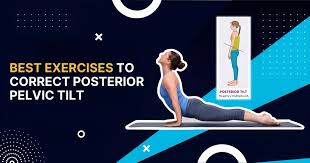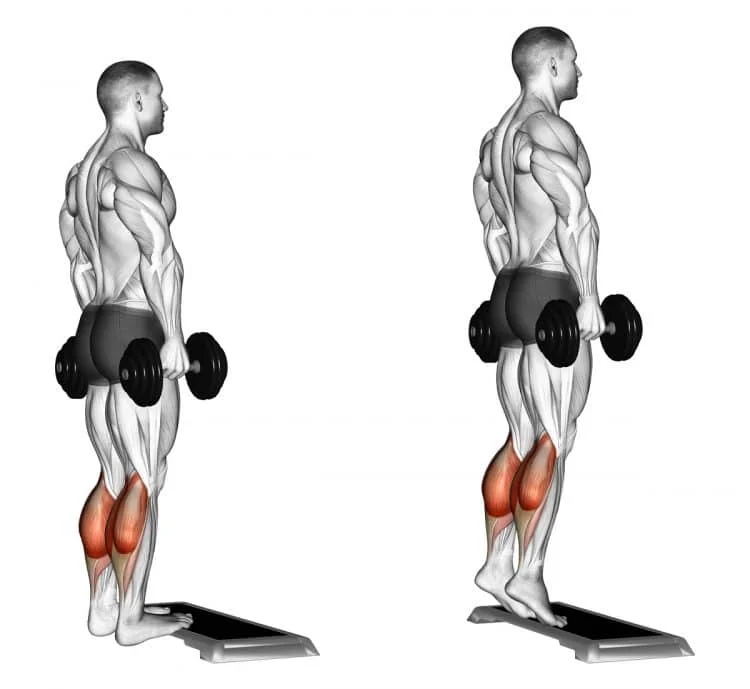Hack Squat Exercise
The hack squat is a useful strength training exercise that primarily works the lower body muscles of the quadriceps, hamstrings, and glutes. The lower back and core muscles are also worked during this effective compound movement. Specialized equipment made to resemble a squat while supporting the back and neck is usually used to conduct the hack squat.
Introduction
Traditional squat variations that target different muscles and advanced levels will help you achieve next-level improvements in leg strength. Experience hack squat variations that challenge every leg muscle, from the core to the calves, to build a balanced lower body for an intense and efficient workout.
The quadriceps, calves, hamstrings, glutes, and core are all worked out during a hack squat. Your front legs will eventually be impacted as a result of your increased attention on your quadriceps. A hack squat is a fantastic approach to increase leg strength if you’re new to the squat. Include the hack squat in your daily workout routine if you want to increase the size of your quadriceps and other leg muscles.
The angle at which the exercise is performed on a machine is similar to that of the leg press, which is how hack squats are performed. Hack squats, on the other hand, focus primarily on the hip joint and involve the same joint action as a standard squat.
You must do a standard squat while standing on a fixed platform in the hack squat. Hack squats are unique among exercises because they make use of fixed equipment that concentrates the strain on the target muscles while maintaining safety, which decreases the need for stabilizing muscles.
What is Hack Squat?
Although the hack squat is becoming more and more popular on social media, it is not a brand-new exercise. In actuality, it has been an effective method for developing strength, power, speed, and agility.
The hack squat is an exercise that combines the upright body position and weight loading of a barbell squat with the stability of a leg press. It can be best explained as a combination of these two exercises. The lifter stands on a work surface and the weight rests on their shoulders when performing the hack squat on a hack squat machine. The lifter drives the weight through their feet as they squat down and then push it upward.
Who Should Perform the Hack Squat?
- Beginners
The hack squat can help beginners who are new to lifting and squatting develop proper technique because it keeps the body up and requires some core engagement without a big weight. It’s also an excellent way to work on hip flexibility, which is a necessary ability but may be difficult at first. Because of the way the bar is positioned, you have to bend your hips slightly to squat. You don’t even need a barbell to learn how to perform this exercise for beginners.
- Weightlifters
The main goals of weightlifters are to get more repetitions out of the bench press, deadlift, and squat. The hack squat is a great way to develop your quadriceps and legs and lift a little bit extra weight without putting too much effort into your upper body. Finally, the additional leg strength you gain with the hack squat will help you attain your weightlifting goals and benefit your big lifts.
- Professional bodybuilders
Professional bodybuilders work out hard and dedicate a lot of time to target and grow specific muscles. They also need to work on compound exercises and keep their entire body coordinated well. This is when the squat and other functional exercises come in useful. Because of its additional focus on the quadriceps, the hack squat is a wonderful way to continue your functional training while targeting specific muscles.
Activated Muscles for the Hack Squat:
When performing the hack squat, it’s important to carefully participate in the right kind of muscles. Your muscles can release stress, allowing you to move heavier objects and protect your joints. The hack squat strengthens your core while also working your lower body.
Your core consists of the transverse and rectus abdominis muscles on the front of your body. There are the obliques that round your body from the inside out. Two of the posterior core muscles are the latissimus dorsi and the muscle known as the quadratus lumborum (QL). During the hack squat, you should fully tense all of your core muscles to prevent your spine from shifting under pressure. Your erector spinae and (QL) quadratus lumborum will help protect your lower back, and your lats will help you maintain tension while holding the bar.
- Glutes muscles
In the hack squat, push through your heels and feet to activate your glutes. The gluteus maximus, gluteus minimus, and gluteus medius make up this powerful muscular group. Thick glutes allow you to lift weights safely by strengthening your hips and supporting your hip flexion in the hack squat. Your glutes also help in hip extension. In your Hack a Squat, maintain a strong stance and notice how your quadriceps, hamstrings, and glutes work together to extend your hips.
- Hamstrings muscles
The hack squat will engage your hamstrings and posterior cord, but not as much as other workouts like the deadlift. Your hamstrings, or biceps femoris and semimembranosus, help with hip and knee flexion. It’s important to engage your hamstrings during the hack squat for perfect full-body engagement and tension.
- Quads muscles
The weight placement in the hack squat during this exercise attracts extra attention to your anterior chain and quadriceps. Your quadriceps are made up of four muscles: the intermedius, vastus lateralis, vastus medialis, and rectus femoris. Your quadriceps are in charge of your knee flexion as you lower yourself from a squat and your hip extension when you stand up.
Advantages of the Hack Squat exercise:
- Simple to put together
It’s kind of like a reverse leg press in that you just add weight plates to the machine, saving you the trouble of managing a barbell and squat rack.
- Maintains stability
Unlike squats performed with free weights, which need a lot of core stability, hack squats keep your hips and upper back in a stable position.
For that added stability, barbell back squats are a good option if you’re new to the weight room. Since you can’t fall forward or backward and you don’t have to balance free weights, hack squats are safer than barbell squats. This is particularly true if you’ve never worked out before.
- It is simple for a beginner to get it done
Beginners can do the machine-supported hack squat with little support on form and technique. Because the machine continuously stabilizes you, you are less likely to make a mistake or lose form when completing a hack squat.
- lowering the spine’s burden
Barbell front and back squats are a great lower body exercise that also needs a lot of upper body strength and mobility. These come from your spine, particularly your upper back. The hack squat is a helpful alternative if you wish to perform a deep barbell squat while resting your upper body.
- Improve Your Mobility
The hack squat demands your shoulders to be stretched, but it does it with less flexion than the front or back squats. Their range of motion may be improved by removing weight from that region.
- Improve Your Physical Performance
For runners or any other athlete who has to run fast for their sport, hack squats are a great workout. Your whole focus will be on moving weight with your lower body. It will strengthen your legs, glutes, and feet. Running benefits from the same attention to your quadriceps that hack squats provide.
Your progress will be faster with a more powerful quad. You can work your feet and glutes with hack squats, and for speed training or other sports, you should always plant your feet correctly.
- Increase Strength of Lower Body
Exercises like the hack squat may be done effectively with large weights since it work the quadriceps, hamstrings, and glutes. With less strain on your lower back than barbell squats or deadlifts, hack squats are a great way to build strength in your lower body. This is so that your lower back can focus more on targeting your legs while putting in less effort.
- Strengthening of the Knee
Many weightlifters avoid the hack squat entirely because it is widely known to have a significant negative impact on the knee. In contrast, this could beneficially strain the knee’s connective tissues in healthy individuals with knee troubles, which could result in long-term improvements in joint health.
Like with muscles, lifters need to have the ability to bear some pain and strengthen any joint. Applying (acceptable) stress to the joint is the best method to improve joint strength; progressive volume, proper loading, and correct technique can help achieve this.
How to Properly Perform Hack Squats:
- Setup the machine
To begin, set the hack squat machine to your preferred height and level of comfort. A comfortable shoulder resting on the shoulder pads is necessary. Make sure your feet are hip-width apart on the platform.
- Position of the feet
It is important to have your toes pointed slightly outward and your feet slightly lower than your hips on the platform. It will be simpler for you to focus on your quadriceps as a result.
- Holding onto the handles
For balance and control, hold onto the machine’s provided handles during the workout.
- Performing
Holding your back against the pad, flex your knees to gradually release the pressure. As you lower yourself, your knees and toes align. After you have your knees 90 degrees apart, keep lowering the weight.
- Pushing up
Put pressure on your heels to bring the weight back to its starting point. Confirm that your knees are not locked.
- Breathing in
As you reduce the weight and as you raise it back up, take a breath. Be consistent and keep your cool during the activity.
- Repetitions
Find out your current level of fitness and modify the weight to accomplish 8–10 repetitions.
Evaluation And Choice:
There are several things to take into consideration while choosing the best hack squat alternative for your routine of physical activity. First, decide which specific muscle groups you want to work on, and then select an activity that will work those groups well.
Second, make safety and injury avoidance your top priorities by choosing workouts that suit your fitness objectives and ability level. Make sure you are connected to the required tools for a good performance by evaluating each alternate exercise’s equipment availability and basic usage.
Evaluate the possibility for progression, general muscle activation, and ability to transfer to other workouts and activities when evaluating the effectiveness of any alternative exercise.
A fitness expert or trainer can help you choose the best options depending on your needs, goals, and personal preferences. Consulting with one of these professionals is advised.
Hack Squat Exercise:
It’s important to understand the hack squat exercise itself before attempting any other workouts. The hack squat calls you to stand with your feet shoulder-width apart and your entire body below a barbell. You lower yourself into a squatting position with your back against the workout platform, then push yourself back up to the starting position.
A hack squat works the quadriceps, hamstrings, glutes, and calves, among other muscles. In addition to straining the knee joint, the activity requires careful technique and security measures. It’s important to understand safety precautions and frequent mistakes related to the hack squat because improper form or going beyond your comfort zone can result in injury.
Exercise Variations for Hack Squat:
The hack squat machine locks your body into a hard, static position, making it difficult to modify and improve the exercise. You need to include the proper squat variation in your workout routine.
Plie Squat
- Choose a dumbbell or kettlebell and place it horizontally on the floor.
- Take a wider stance than shoulder width and raise your arms straight up to the floor.
- Bend down and grasp the dumbbell or kettlebell with both hands.
- Maintain a tight abdominal core and squarely plant your feet on the ground as you stand upright.
- Hold this position for a few seconds.
- Then return to your neutral position.
- Then relax.
- Repeat this exercise 5 to 10 times.
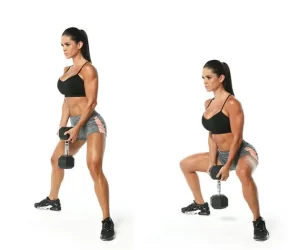
Landmine Hack Squat
- After inserting one end of the barbell into the landmine mechanism, pose with your back to the other end.
- Put your feet hip-width apart while bending your knees slightly.
- Standing tall and with your knees bent slightly, place your feet shoulder-width apart.
- Placing your shoulders exactly over your hips will help you maintain an upright head and neck posture.
- Your chin should be pulled in during the entire workout.
- Divide your weight and use your feet to hold the ground to create an upright foot position.
- Fully grasp the bar by putting both hands around its end.
- Maintain a near-rib position with your elbows.
- Activate your center of gravity.
- The pelvis should be slightly pushed in when your ribs are lowered.
- For every repetition, start here.
- To begin heading down bend your ankles, knees, and hips.
- Lower yourself till your legs are parallel to the ground or just barely off it.
- Your feet should be equally distributed with your weight.
- Stop when at the lowest position.
- Press your feet into the ground as you take a step up to a standing position.
- While keeping toe contact, concentrate on regulating your heel and midfoot.
- Keep your chest elevated, tighten your glutes, and allow your knees and hips to straighten as you begin to stand.
- As the exercise is completed, tighten your glutes and quadriceps while keeping your spine neutral.
- Then return to your neutral position.
- Then relax.
- Repeat this exercise 5 to 10 times.
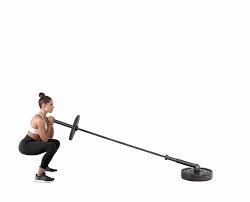
Heels Elevated Hack Squat
- Place some weight plates or a squat block on the ground.
- When placing your feet there, they should be a little wider than hip-width apart, with just your heels on the elevated platform.
- You must have been able to touch your toes.
- Squat down gradually after taking a deep breath and contracting your quads and core.
- Stop when the movement reaches its lowest point.
- Then return to your neutral position.
- Then relax.
- Repeat this exercise 5 to 10 times.
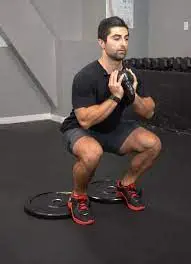
Leg press machine
- With a leg press machine, there is an ideal manner in which your body should be positioned.
- Place your head and back comfortably against the padded support as you sit on the machine.
- Keeping your heels level, place your feet on the footplate about hip-width apart.
- Be careful to maintain this position while you press.
- Holding onto the helper handles will help to support and maintain the proper position of your head and spine.
- Squeeze your abdominal muscles while using your forefoot and heels to push the platform away.
- Staying flat on the footplate is important.
- It is not necessary to move the pad forward only with the front of your foot or toes.
- Breathe out while extending your legs, keeping your head and back flat against the seat pad.
- Instead of moving quickly, extend with careful control.
- When the movement reaches its maximum, it comes to a stop.
- Keep your knees from locking out and make sure they are not bending in or out.
- Breathe out and slowly bend your knees to get the footplate back to its starting position.
- Every step of the way maintain a flat back and feet.
- Then relax.
- Repeat this exercise 5 to 10 times.
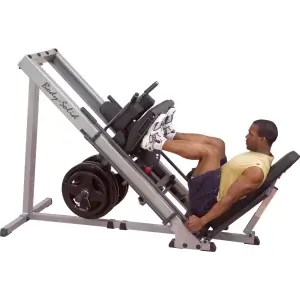
Sumo deadlift
- At the beginning, keep your posture wide and position your feet slightly out in front of a weighted barbell.
- Ensuring your arms are inside your knees is a sign of a suitable posture.
- Elbows should be slightly inside your knees while your hands are on the bar inside your feet.
- While keeping your core tight, move your hips toward the bar.
- When you contract your glutes, lower back, and legs, make sure all of your muscles are activated and your body feels fully awake.
- Turn your quadriceps to force your femurs to spin open in your hip sockets so that your knees are in line with your feet and toes.
- Slide your shoulder blades back and forth on the bar with an overhand or mixed grip to lock them in place.
- Pull up on the bar until it meets the top of the weight plate’s circle while keeping your legs pressed into the floor.
- Raise the bar a little higher for now.
- Maintain a straight back and a wider chest.
- Pull the bar as close to your body as you can while putting pressure through your heels to elevate yourself.
- As you squeeze your glutes to reach the highest position, fully extend your hips and knees.
- Reverse the action carefully and slowly while keeping the bar in touch with your body to avoid straining your lower back.
- Then relax.
- Repeat this exercise 5 to 10 times.
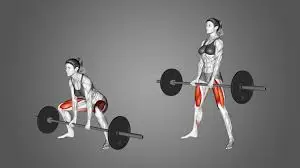
Hack squat with Smith Machine
- To begin, lower the Smith machine’s bar until it is just barely over your ankles.
- Position the bar slightly behind your legs, keep your feet shoulder-width apart, and point your toes forward while standing.
- Bend down and use an overhand hold to grab the bar from behind while keeping your feet firmly planted on the ground.
- To raise the bar, extend your hips and knees, being careful not to lock your knees.
- Lower yourself into a squat once your thighs are parallel to the floor.
- Maintain this position for some time.
- Then return to your neutral position.
- Then relax.
- Repeat this exercise 5 to 10 times.
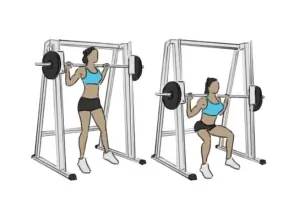
Reverse hack squat
- First, it is necessary to adjust the height of the shoulder pads.
- They should be just below chest height, so you have to bend your knees a little bit to get to them.
- Choose a weight that will challenge you enough so that you can perform the exercise with the correct form on multiple occasions.
- Placing the back pad in front of your chest, turn to face the machine.
- Keep your feet close to the platform’s base, with just enough space between them and the machine, so that your knees can bend easily.
- Maintaining your feet shoulder-width apart, comfortably place the shoulder pads on your traps.
- You can let go of the weight when you can stand up straight and extend your knees fully.
- Your body can be centered by moving your feet around on the platform.
- Confirm that your feet are spaced nearly shoulder-width apart.
- Lower yourself toward the platform by squatting down, allowing your knees and legs to extend up to your toes.
- Allow your hips to go down as you recline.
- Confirm that your back is straight and not overly bent.
- If you allow your butt to drop below your knees, your quadriceps will contract significantly.
- After just a few seconds of holding at the bottom of the action, carefully bring your hips and knees back to the starting position.
- Keep your hips and knees slightly bent at the highest point of the exercise to keep continuous quad tension.
- Then relax.
- Repeat this exercise 5 to 10 times.
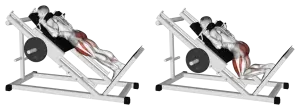
Goblet Squats
- Pick up a dumbbell that is moderately heavy and hold it vertically (one side up) in front of your body with both arms.
- Put your palms firmly under the weight plates and place your hands on the sides of them to keep them from slipping through.
- Breathe deeply into your belly while maintaining neutral posture on your back.
- Break at the knees to lower yourself into a squat while keeping your body as upright as you can.
- To avoid losing your balance, you want to maintain your weight exactly over your center of gravity, which is the middle of your feet.
- As comfortably as possible, squat until your thighs should be parallel to the floor.
- Exhale close to the top of the repetition after pushing through your heels to return to the starting position.
- Inhale once more and lower into a squat.
- Then relax.
- Repeat this exercise 5 to 10 times.

Bulgarian Split Squat
- Start this exercise by placing your feet shoulder-width apart and squatting slightly in front of a bench.
- Your body should be pointing forward and away from the bench at this point.
- Grasp a barbell that is positioned in front of you with your palms facing the floor and raise it to your chest.
- Lift the barbell strongly above and set it down on your shoulders.
- Alternatively, use dumbbells, an overhand grip, and bring your arms close to your body’s center.
- This is the time to step one foot backward so that it rests on the level bench and place the other foot in front of you.
- Your head should always be pointing forward during this initial phase, and your back should always be rigid and straight.
- As you breathe in, progressively pull your leg down until you get a contraction.
- Make sure, though, that your knee is above your toes and is not touching the floor.
- Still, face ahead at all times with your chest out and your back straight.
- Return your leg to the beginning position while exhaling and contracting your quadriceps.
- Then relax.
- Repeat this exercise 5 to 10 times.
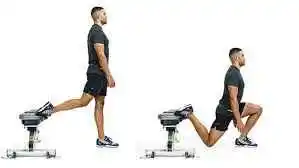
Barbell Hack Squat
- Place your barbell on the floor to begin.
- Place yourself in front of it.
- With your heels on the bar, place your feet shoulder-width apart.
- Stretch your arms out to the sides apart from your legs.
- Slightly extend your shoulders and reach back.
- Without exposing your ribcage, pull your shoulder blades downward and back.
- As you squat down, turn your hips and allow your knees to flex slightly.
- Use an overhand grasp for control of the barbell behind you.
- Put your feet down firmly on the floor to stand up.
- After standing up, take a breath to strengthen your core and lower your hips to begin the squat.
- Throughout, maintain a relaxed arm position.
- Then relax.
- Repeat this exercise 5 to 10 times.
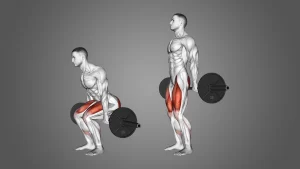
Front Squats
- To place your hips under the bar in the squat rack, bend your knees and raise the bar to a height that is mid-shoulder.
- There’s a bar under your chin, by your clavicle.
- Your thumbs should be placed outside of your shoulders at this point so that you may hold the bar.
- Grab the bar with your elbows and pull them forward.
- Lean back a little while you straighten your legs and release the bar.
- Maintain a confident posture with your elbows aligned with your shoulders while engaging your core.
- Maintain the barbell above your midfoot and go down your hips into a squat such that your thighs are parallel to the ground or less.
- To force yourself back to your feet, push strongly into the floor.
- Then relax.
- Repeat this exercise 5 to 10 times.
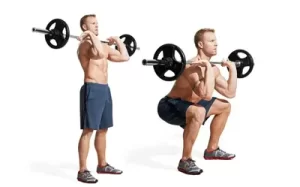
Hatfield squat
- You will need a platform, barbell, and safety squat bar to do this hack squat option.
- The barbell should be raised to rest a bit below your chest.
- You’ll be able to find the most comfortable position as you practice the movement; perfection is not necessary.
- Next, position the safety squat bar at the standard squat height.
- Position the safety squat bar on your back as you reach the rack for support.
- The safety squat bar sits passively on your back, and you’ll hold onto the balanced barbell instead of the handles. This is where all begins.
- You will then squat down while holding to the racked barbell.
- Let your butt down further while keeping your body upright because you are holding onto the barbell.
- Don’t forget to maintain the heels vertical so that your knees experience the greatest amount of flexion.
- When you are at the bottom, maintain the well-known “sitting position”.
- Shoulder-width apart is the ideal distance for feet.
- After that, you’ll push your body to its maximum extension.
- Then relax.
- Repeat this exercise 5 to 10 times.
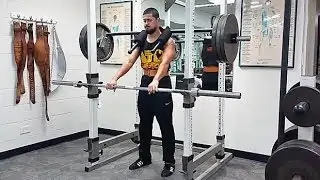
Dumbbell Hack Squat
- Step out with your shoulders wide and plant your heels on a weight plate or squat wedge.
- Find a comfortable position by slightly extending your toes.
- Placing the backs of your palms against your hamstrings, take a dumbbell in each hand.
- The wall behind you should be facing your hands.
- Look directly ahead while maintaining a straight posture.
- This is where you’ll start.
- Bend at the knees and press them forward to bring them closer to the floor.
- During the whole range of motion, maintain your entire body parallel to the floor.
- Get down as low as you can.
- You should feel your hamstring at the bottom touching your calves.
- Push through your heels to reposition yourself in the beginning posture.
- Then relax.
- Repeat this exercise 5 to 10 times.
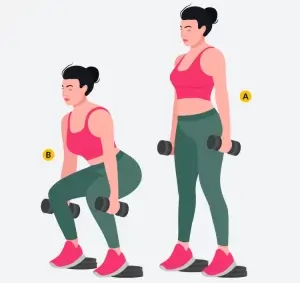
Sissy Squat
- While working, position yourself near to a squat rack or anything else you can grab for support and balance.
- Keeping your feet about shoulder-width apart, place your heels on the floor.
- Have your shoulders back and stand tall.
- Breathe deeply into your abdomen, then contract your stomach.
- Bending your knees, extending your upper body back, and lifting your heels off the ground will help you lower yourself into a squat.
- Lower yourself to the lowest comfortable position, hold for a short time, then flex your quadriceps to bring your knees straight.
- Near the highest point, release the breath.
- Then relax.
- Repeat this exercise 5 to 10 times.
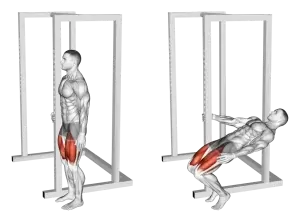
Narrow hack squat
- Start this exercise by lowering your shoulders under the hack squat machine’s back pads, keeping your back flat on the pads.
- Next, place your legs less than shoulder-width apart in a very narrow stance with your toes pointed out.
- Bend your knees and extend your legs without locking them before lowering the machine.
- Put your upper legs and knees at a ninety-degree angle by continuing this action.
- Raise your heels and push yourself up to return to the starting position.
- Then relax.
- Repeat this exercise 5 to 10 times.
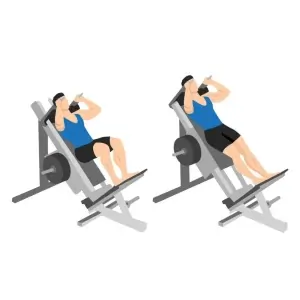
Zercher Squats
- Start with your feet up in front of the squat rack and the bar slightly below elbow level.
- With your chest raised and staying strong, lift the barbell in the bend of your elbows.
- As you take a few steps back and spread your feet apart, ideally a bit wider than your hips, you should be back in the squat posture.
- Return to a low squat by pushing your hips.
- To firmly raise yourself back up to the starting position, press your heels into the ground.
- Then relax.
- Repeat this exercise 5 to 10 times.
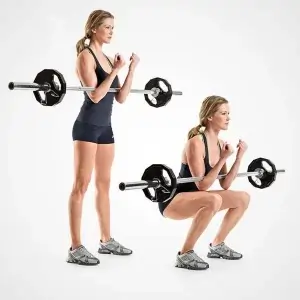
Belt Squat
Attaching the barbell plates to the machine or, if you’re using a dip belt or pin-style belt, to the chain is necessary before starting a belt squat session.
- Place yourself on the raised platform with your feet shoulder-width apart or slightly wider apart.
- To make sure your legs are far enough apart to prevent hitting the weight plate, you might need to extend your toes outward.
- Breathe in, bending your knees and lowering your body toward the floor.
- Instead of letting go of the weight, manage your movement to activate your quadriceps.
- As you lower yourself, remember to inhale.
- Using your heels as an advantage, lift yourself from an upright position to a standing posture.
- You will strengthen and activate your quads more when you move slowly and carefully.
- Exhale as you stand up.
- Refrain from rapidly jumping up, as this will not improve your strength.
- As you come to the top of your squat, keep your knees slightly bent rather than straightening them out entirely.
- Activate your glute muscles by pushing your hips forward.
- Take a moment to relax before moving on to the next repetition.
- In addition to allowing you to correct your posture as needed, this will help you keep the movement straight and under control.
- Then relax.
- Repeat this exercise 5 to 10 times.
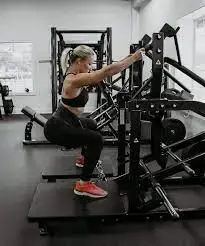
Maintaining Correct Form And Avoiding Injuries:
To avoid injuries and provide maximum muscle activation, it’s important to maintain perfect form and technique when performing hack squats. Knee protectors are a particular way to improve your form and provide your knees more support. By providing compression, these pads can help the knee joint maintain proper alignment throughout the squat exercise.
They also offer a protective covering that lowers the possibility of strains or overextension. For the duration of the workout, stay away from excessive bouncing or jerking and concentrate on controlled, fluid motions. Knee coverings could provide some help if you hurt or feel uncomfortable when performing hack squats, particularly in the knee area. In case of persistent pain, discontinue the workout immediately and get medical advice.
When performing hack squats, stay away from the following typical mistakes:
- You need to modify where your feet are positioned on the platform slightly, but otherwise, your hack squat form should be the same as a standard squat.
- Rounding your lower back, elevating your heels off the ground, and gradually increasing the weight.
- To receive the best effects, concentrate on working the targeted muscles in a thoughtful, stable way.
- Make sure your feet are slightly higher up on the platform so that when you squat, you can keep your knees over your heels and maintain a healthy 90-degree angle between your hips and knees.
- During a squat, if your feet are too near to the surface of your body, your knees can extend over your toes, putting additional pressure on your knee joints.
- The hack squat machine is the best equipment to use if you have the opportunity to squat a lot because it has so many regulated features.
- In other words, if you squat too low to get back up, you won’t have to worry about slipping and falling over a heavy barbell.
Safety precautions and comfortable training advice:
Any exercise, even hack squats, requires you to focus on technique and safety. Take careful consideration of the following guidance to guarantee a safe and effective workout.
- It’s important to stretch and warm up properly before beginning hack squats. It is necessary to warm up and prepare your muscles for the exercise.
- Try doing light cardiovascular exercises like cycling or jogging to increase blood flow to your muscles. Because they target the muscles utilized in hack squats, stretching exercises like leg swings, walking lunges, and hip rotations are also effective.
- Hack Squat Setup Modification you must adjust a hack squat machine to your specific body composition if you are using one.
- To provide the maximum range of motion and proper posture, make sure the shoulder pad is resting comfortably on your shoulders and upper back.
- It also has adjustable seat height.
- If you are unfamiliar with strength training in general or hack squats in particular, it is advisable to consult with a professional personal trainer.
- A personal trainer can assess your level of fitness, teach you proper form and technique, and create a customized exercise plan that fits your objectives and limitations.
- They can also provide helpful suggestions and motivation to help you improve and avoid getting hurt.
Who Must Not Perform the Hack Squat:
- You Have Joint Problems
The hack squat is a stable motion. That does not always help individuals who have knee or hip problems. While the hack squat reduces some of the stabilizing features of traditional squats, it still requires nearly full-body engagement. Pushing someone with knee or lower spine difficulties through a set range of movements can lead to chronic pain. If you have lower back or knee problems, skip ahead.
- Performance Is Your Objective
The hack squat might not be the ideal workout for you if your goal is to increase your athleticism for any sport, not only basketball or football. On the one hand, strength of any kind improves performance, and hack squats are a surefire way to gain strength.
You shouldn’t spend your time this way, though. It’s not making it difficult for you to use your upper body for stability or preventing you from using your lower body in a natural, athletic manner. Yes, if you’ve finished your deadlifts, lunges, and free-weight squats, then sure, including the hack squat.
However, if you want to play on a field of play, the hack squat should be your least important leg workout. The environment won’t have as many fixed factors in athletics as it does in the hack squat.
Summary
A highly effective leg exercise that can help you develop lower body strength and power is hack squats. Hack squats are an excellent leg exercise with many benefits that can help you meet your fitness goals. A combo workout that primarily targets your legs’ quadriceps, hamstrings, and glutes is the hack squat.
The hack squat is a great exercise to build muscle in your legs, particularly your quadriceps. You can also try a few variations to receive even more benefits. Whether you are a new lifter, bodybuilder, powerlifter, or anywhere in between, hack squats are a good exercise to add to your workout routine.
When performing a hack squat machine or utilizing a barbell, it’s important to focus on form, safety, and technique. Alternative hack squat variations, like reverse hack squats, may give your leg muscles a different kind of stimulus. Additionally, you need to consult a personal trainer, particularly if you’ve never engaged in strength training or a hack squat.
FAQs
What does the Hack Squat mean?
A popular leg workout that tones your glutes, quads, and adductors is the machine hack squat. The hack squat is a combination of the leg press and the barbell squat. It makes use of a more sturdy machine than the leg press, but it still trains your quadriceps and requires an upright body position, just like the front or even the squat.
Should you do hack squats or not?
As long as you load and increase the exercises gradually, hack squats are not harmful to your knees. They can help you in developing knees that are healthier, stronger, and capable of handling any task. All you need to do is always pay attention to your body, modify your workout as necessary, and get guidance from professionals when necessary.
Doing hack squats or regular squats is better?
Although they both work the lower body well, hack squats and barbell squats are different in a few significant ways. The growth of your quads may be greater with hack squats if you’re a bodybuilder. Barbell squats may be a better exercise for strength and specificity if you are a powerlifter.
What goes well with a hack-squat combination?
Hack squats should be part of an extensive leg workout program to enjoy their full advantages. Hack squats can be combined with other leg workouts to target different muscle groups and movement patterns, such as leg presses, lunges, hamstring curls, and calf raises.
Is hack squats suitable for beginners?
Although the hack squat machine is a good option for beginners, you may also perform a hack squat variation with a barbell. It’s a bit of an advanced movement. Strong upper body muscles are necessary to maintain enough weight that affects your lower body.
Will doing hack squats result in larger legs?
Hack squats involve engaging the quads and glutes more so than the back or core. While they can help in the development of leg muscle, normal squats are also a good option unless you’re a professional bodybuilder.
Is squat easier than hack squat?
While the muscles used in both exercises are the same, there are notable differences. Because you don’t have to worry about form or balance the weight, hack squats are simpler to complete than barbell squats.
Should I squat deep at all times?
You will typically have more general benefits, such as increased muscle growth, strength, and mobility when you train in the widest range of movement that is practical in the working joints. At this moment, kneel as low as you can if you are unable to go down much farther.
In reverse, what does the term “hack squat machine” mean?
The reverse hack squat is performed with your back to the same equipment. To set up, just place your shoulders under the pad, as your back is not on it. Flex your hips and push your buttocks back down.
What is the primary focus of the hack squat?
The quadriceps, which are found at the front of the thigh, are the main muscle group that hacks squats target, although these muscles are good for leg growth in general.
Can I practice squat workouts daily?
Regularly squatting has benefits. Also, compared to lifters of shorter limbs, longer-limb lifters appear to be worse squatters. A superior form is one of the benefits of frequent squats. The usage of opening pauses may improve strength and position.
What Are the Alternatives to Hack Squats?
Many additional exercises can be substituted for hack squats, according to the result you want.
Landmine Hack Squat
Smith Machine Hack Squat
Reverse Hack Squat
Leg press machine
Is there anyone who wouldn’t prefer squat?
Elderly persons need to stay away from any activity that requires them to bend their knees deeply, even if squats are a great way to build muscle in your legs. Deep squats put a strain on knee joints, which are commonly impacted by arthritis. Maintaining good form during squats can be difficult for people with back or leg problems.
Do athletes get any benefit from hack squats?
You can improve speed in sports like running by strengthening your legs. For help with this, try the hack squat. Because your trunk is not being used, you may exert much more pressure on your quads than you would in a back squat. This is better for quad development.
References
- October 27, 2023; Singh, A. Tones your hips with hack squats: This is how the glute workout should be done correctly. Health Shots is a website that offers information on muscle gain, fitness, and hack squats. Citation inside the text: Singh, 2023
- Worked Muscles & Correct Form: Sumo Deadlift Technique. (n.d.). A sumo deadlift is offered by Strength Log at https://www.strengthlog.com/. Source for in-text citation: Muscles Worked & Proper Form: Sumo Deadlift Technique, n.d.
- The Leg Press: A Safe Method. The link /How-to-Do-the-Leg-Press-3498610@verywellfit.com/ is appropriately fitted for Thanksgiving on November 3, 2022. “The way to Perform the Leg Press correctly, 2022).” is cited inside the text.
- November 22, 2019; Davis, N. How to Correct Your Squat. [https://www.healthline.com/health/fitness-exercise/proper-squat-form#] is the basic bodyweight squat form. Within-text citation: Davis, 2019
- Hack Squat Technique: Advantages & Activating Muscles. (n.d.). Visit https://www.strengthlog.com/hack-squat-machine to access Strength Log. Internal Reference: (Muscles Worked & Advantages of Knowing How to Do Hack Squats, n.d.)
- M. (Thursday, May 2, 2022). The Reverse Hack Squat’s Benefits And Methods Hack Squat in reverse: This link: https://soma.fitness/2022/05/02/SOMA. SOMA Reference within the text: (2022)
- S. F. SET (unpublished). The Top 8 Hack Squat Alternatives: Targeting the Same Muscles. IN FOR A SET. Hack-squat substitutes: News & Blogs – https://www.setforset.com SET, n.d. is cited inside the text.
- September 30, 2022, Boyce, L. Dissolving Muscle: The Advantages of the Hack Squat, Its Variations, and More. breaking muscle.com/hack-squat on fracturing muscle Inside the text citation: Boyce (2022)
- Rogers, P. (November 3, 2022). Method for Leg Press Exercise. well-fitting. /How-to-Do-the-Leg-Press-3498610@verywellfit.com
Reference within the text: Rogers, 2022 - Luna, D. ( December 3, 2022). Six Exceptionally Powerful Hack Squat Substitutes (With Images). Motivate US. The hack-squat alternative is available at https://www.inspireusafoundation.org.
Reference within the text: Luna, 2022 - Appleton, C. July 26, 2021. Bulgarian Split Squat: Form and Method Bulgarian split squat exercise: appropriate form and lift technique (https://www.myprotein.co.in/blog/training/)
Reference within the text: Appleton, 2021 - Image 1, Lohre, J. (15 January 2024). Techniques for performing Plie or Sumo squats. Lohre Julie. [Lohre, 2024] In-text Citation: https://julielohre.com/sumo-squat-plie-squat/
- Image 2, Online Fitness Programs | AFA Can Help You Become a Personal Trainer. March 28, 2024. Academy of Australian Fitness. This website, fitnesseducation.edu.au
Internal Reference: (Online Exercise Programs | Train to Become a Personal Trainer With AFA, 2024) - Image 3, Goblet squat with the heel raised (n.d.). See https://www.kna-99.buzz/products.aspx?cid=34 and name=heel+elevated+goblet+squat
The cited source is Heel Elevated Goblet Squat (n.d.). - Image 4, Online Leg Press & Hack Squat Machine for Body-Solid Cam Series in India. (September 19, 2020). World of Fitness. Exercise World India’s product page for the GLP-1100-leg-press-hack-squat machine
In-text Citation: (Online in India, 2020, Body-Solid Cam Series Leg Press & Hack Squat Machine) - Image 5, Neudecker, K. March 23, 2023. How to Deadlift Perfectly to Increase Muscle, Strength, and Set New Personal Records. Male Health. Here’s how to deadlift: https://www.menshealth.com/uk/how-tos/a748582
Reference inside text: (Neudecker, 2023) - Image 6, Squats with the Smith machine – Go Fitness Plan (n.d.). Smith machine squats can be found at https://www.gofitnessplan.com/exercises.
In-text Citation: Go Fitness Plan, n.d.’s Smith Machine Squats - Image 7, D. Luna (2023, Aug. 28). Benefits, Worked Muscles, and More of the Reverse Hack Squat Machine. Encourage US. The reverse hack squat machine can be found at https://www.inspireusafoundation.org.
Reference inside text: Luna (2023) - Image 8, J. Goldthorp (2018) 16 May. Quick Form Tip – Goblet Squat — Fix Your Run | Stronger, Bulletproof Runners by John Goldthorp. John Goldthorp’s Fix Your Run: Stronger, Bulletproof Runners. [https://www.fixyourrun.com/blog/2016/03/form-tip-goblet-squat]
Citation within the text: Goldthorp (2018) - Image 9, Bulgarian Split Squat Barbell. Skimble.com, n.d. Exercise instructions: https://www.skimble.com/exercises/46498-barbell-bulgarian-split-squat
Reference inside the text: Barbell Bulgarian Split Squat (n.d.) - Image 10, 2023 May 25; Luna, D. Four Main Advantages and Worked Muscles of the Barbell Hack Squat. Motivate America. A barbell hack squat is available at https://www.inspireusafoundation.org.
Internal Reference: Luna, 2023 - Image 11, Neudecker, K. March 22, 2023. To ignite your quads and brighten your core, learn how to perform front squats. Male Health. Front-squat: https://www.menshealth.com/uk/how-tos/a735538
Reference inside text: (Neudecker, 2023) - Image 12, July 12, 2019, B. L. How To: Programming Hints & Safety Square Bar. YouTube. /watch?v=IT6hMuj1Y4o
The in-text citation is 2019 - Image 13, March 15, 2023; Saini, V. This guide explains how to perform the Dumbbell Hack Squat, along with its benefits, muscles used, and variations. Exercise Volt. https://fitnessvolt.com/squat-hack-guide-dumbbell/
Internal Reference: (Saini, 2023) - Image 14, Faturohman, T., and Meiliana, V. F. (2023, August 12). An analysis of the demand for rice trading products in PT XYZ using a machine learning algorithm for e-commerce product modeling. Current Science Research and Review: An International Journal, 06(08). The article’s DOI is 10.47191/ijcsrr/v6-i8-35.
Reference within the text: (Meiliana & Faturohman, 2023) - Image 15, Putra, L. (January 3, 2023). Download the isolated flat vector image of a man performing a hack squat on a white backdrop. 8418359 roy… Vecteezy. https://www.vecteezy.com/vector-art/8418359-vector-illustration-isolated-on-white-background-man-doing-hack-squat-exercise-flat
Citation within text: (Putra, 2023) - Image 16, March 14, 2015 / S. Five Benefits of Including Zercher Squat in Your Exercise Routine. Look through Pinterest. In Pinterest: https://in.pinterest.com/pin/413909021984821553/
Citation within text: (2015) - Image 17, K. Pierce (1997). The front and belt squats. Journal of Strength and Conditioning, 19(5), 60. The dataset 107.1519/1073-6840(1997)019<0060:fsabs>2.3.co;2
Citation inside the text: Pierce (1997)



